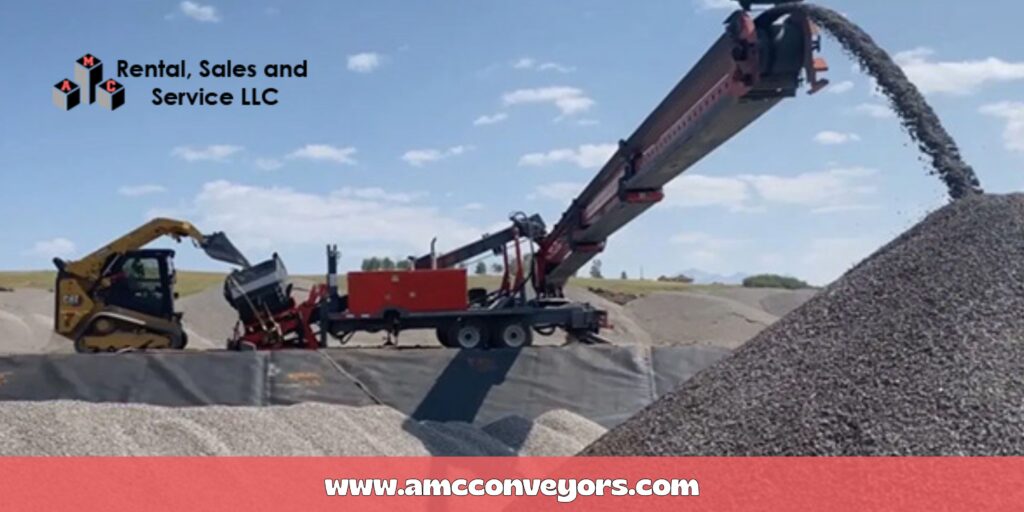Construction projects are certain deals that have to be fulfilled on a given timeline. So, you need to be very precise about your efficiency and productivity inclusions. This is where the relevance of a conveyor belt in construction comes into the picture. This element somehow eases the complex tasks of transporting gravel, sand, or debris. Due to the heavy usage of conveyor belts in multiple industries, the market size is going to reach USD 8.3 billion by 2032.
In this post, we’ll cover the key maintenance practices to keep your conveyor belt for construction running efficiently. From cleaning and alignment checks to component replacement and tension monitoring, you’ll learn practical steps to extend your equipment’s lifespan and avoid costly downtime.
However, it is critical for you to keep the efficiency of the conveyor belts consistent to maintain your construction project’s values. Midway halts can significantly delay the whole project. So, this blog can be your ultimate guide to maintaining your conveyor belts on a construction site.
Why Conveyor Belt Maintenance Can Safeguard Your Productivity?
If your conveyor system is well-maintained, it can offer you smooth operations, safety, and reduced downtime. It is very hard to maintain the system in a construction site as it converts into a harsh environment due to excessive dust and moisture levels.
So, without timely maintenance, your conveyor belt for construction might slip or tear. Most of the time, the misalignment leads to uneven material flow and impacts the rollers and motors as well. So, early detection can eliminate the issue in the initial stage.
To further enhance your workflow and site safety, you can explore this detailed guide on how custom conveyors improve workflow and safety for better operational results.
Maintenance Tips to Keep Your Conveyor Belt for Construction Intact
Here are some expert tips you should adopt to maintain the performance of your conveyor belt like new.
- Keeping the conveyor clean and debris-free is your foremost duty
As we have discussed, construction sites become extremely dusty and muddy with time, along with loose materials. All this stress can affect the performance of the belt. With dirt and debris piling up on the belt surface, it can give rise to risks like unnecessary friction and misalignment.
Regular cleaning is one such simple step that can level up your belt’s performance. You can use compressed air or brushes to get rid of build-up on rollers and pulleys. Most importantly, particles that stick to the return side of the belt might damage both sides of the rollers. So, give special attention to that as well.
- Verifying the alignment of your belt for ultimate performance
Many conveyor systems lose their impact due to misalignment. In this situation, the belt drifts towards one side and rubs against the frame. It can further lead to unnecessary wear and tear. Most of the time, this issue arises due to extreme loads or damaged pulleys.
So, it becomes important for you to inspect the tracking of your belt regularly when it’s working. It should be in the middle of the rollers to maintain its performance. To keep up with the conveyor belt’s stability, make sure to buy conveyor rollers. With durable and corrosion-resistant materials, the quality rollers can manage harsh construction conditions as well.
- Replace damaged components
With time, even the strongest belts can lose their performance efficiency. It majorly happens in rough or high-load construction environments. So, it should be your habit to inspect your pulleys, rollers, and bearings along with the belt surface regularly.
There are some alarming signs that can warn you about the damage, and they are squeaky rollers, surface cracks, and loose bearings.
Replace all the worn-out components early to prevent minor issues. Always pick new components that suit your belt’s load capacity and speed requirements.
- Keep your eyes on the belt tension
Belt tension can influence the operational values and efficiency of your conveyor. If the belts are extremely tight, it can put your motor and bearings under stress. On the other hand, loose belts can reduce your productivity while giving rise to risks.
Your conveyor belt for construction should have a proper grip without any chances of slippage.
Proper tension ensures extending the lifespan of your conveyor belts while preventing you from frequent replacements.
- Train your crew for desirable usage
Without proper handling knowledge, your equipment might not offer you the performance you desire. So, to avoid misalignment, slippage, or noise, you must train your team members to understand each aspect of the conveyor belt in construction projects. They should understand the precise operations while having proper knowledge about tackling the issues.
In Conclusion
A well-maintained conveyor belt for construction highlights your potential in the market. So, you must consider the above-mentioned maintenance tips to extend the lifespan of the system. If you are planning to upgrade or buy new systems that handle heavy construction projects, consider the help of AMC Conveyors. They offer high-quality and durable solutions that can meet the tough requirements of your modern construction.
FAQs
- How frequently should I inspect my conveyor belts?
It should be your regular habit to inspect your construction conveyor belts. Regular checks can help you detect early issues.
- Is it possible to extend the lifespan of my conveyor belt?
Yes, to maximize the lifespan of your conveyor belt, you must keep it clean and replace damaged elements when needed.
- Why is my conveyor belt misaligning during construction works?
Misalignment might be happening due to the uneven placement of your rollers, pulleys, and frames. So, make sure to keep your material loading consistent.

